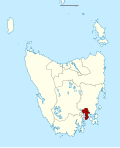| Rumney Tasmania—Legislative Council | |||||||||||||||
|---|---|---|---|---|---|---|---|---|---|---|---|---|---|---|---|
| State | Tasmania | ||||||||||||||
| Created | 1999 | ||||||||||||||
| MP | Sarah Lovell | ||||||||||||||
| Party | Labor | ||||||||||||||
| Namesake | Mount Rumney | ||||||||||||||
| Electors | 27,606 (May 2023) | ||||||||||||||
| Area | 434 km2 (167.6 sq mi) | ||||||||||||||
| Demographic | Outer-metropolitan | ||||||||||||||
| Federal electorate(s) | Franklin Lyons | ||||||||||||||
| Coordinates | 42°49′48″S147°26′20″E / 42.830°S 147.439°E | ||||||||||||||
| |||||||||||||||

The electoral division of Rumney is one of the 15 electoral divisions in the Tasmanian Legislative Council (upper house). The division is located in Southern Tasmania to the east of the division of Pembroke.
The electorate is named after Mount Rumney in outer Hobart. The division covers an area of 434 km2 and includes a number of outer Hobart localities including; Lauderdale, Rokeby, Cambridge, Midway Point and Richmond. [2] The division is held by Labor member Sarah Lovell.
As of the last election on the 6 May 2023, the division had a total enrolment of 27,606 electors. [3]
